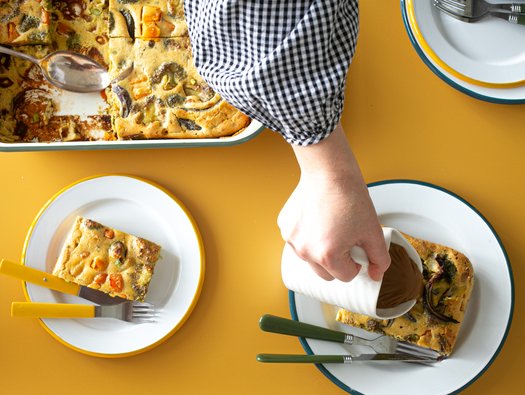Vegetable toad in the hole with Charlie’s gravy

A delicious twist on a traditional recipe that’s high in protein but low in salt, potassium and phosphate.

A delicious twist on a traditional recipe that’s high in protein but low in salt, potassium and phosphate.
2 tablespoons olive oil
1 red onion, peeled & cut into thin wedges
200g butternut squash, peeled & cut into 2cm cubes
200g carrot, peeled & cut into 2cm cubes
100g frozen edamame beans
2 garlic cloves, peeled & crushed
200g broccoli, split into florets
200g gram flour
300ml milk
6 eggs
30g fresh rosemary, chopped (10g dried)
25g plain flour
30g unsalted butter
1 very low-salt or zero salt beef stock cube dissolved into 300ml boiling water
Make the batter: whisk the eggs and milk together and add the rosemary. Pour the mixture onto the flour and whisk until fully combined. Let the batter sit for about 30 minutes.
Preheat the oven to 180°C / 160°C fan / gas mark 4. Pour the oil into an ovenproof dish and add the onion, butternut squash, carrot, edamame beans, garlic and broccoli. Toss the vegetables in the oil. Roast for 20 to 25 minutes, until the vegetables have softened and turned golden brown.
Remove the vegetables from the oven and turn the oven up to 200°C (180°C fan / gas mark 5). Pour the batter over the vegetables, ensuring they are evenly spread out. Return to the oven and cook for 25 minutes or until risen and golden.
Make the gravy: melt the butter in a pan over a medium heat and add in the flour, whisking all the time, cook for 2 minutes and then add in the stock, continuing to whisk continuously to avoid lumps. Cook until it has reduced to the desired consistency.
Remove the toad in the hole from the oven and serve with the gravy.
The gram flour, plain flour, edamame beans and root vegetables are the main source of carbohydrate in this recipe, and the value has been provided for those who have been trained in insulin adjustment.
This recipe is low in potassium, when following the quantities in the ingredients, and the serving sizes. Therefore, suitable for those advised to eat less potassium.
This recipe is also low in phosphate, however it does contain some phosphate, mainly provided by the eggs, therefore if you have been prescribed a phosphate binder you should take as directed.
This recipe is a source of protein, therefore suitable for those advised to eat more protein, for example, those having dialysis. If you have been advised to eat less protein, simply swap the gram flour for plain flour.
This recipe has been kept as low in cost as possible. Frozen vegetables could be used in place of fresh, just allow the frozen vegetables to defrost first.
Use a gluten free flour and stock cube to make the gravy.
Stock cubes can often be high in salt. We use very low salt or zero salt stock cubes and avoid those with potassium additives such as potassium chloride.
This dish is best eaten freshly made.
If you have been advised to limit your fluid, then the fluid within the gravy should be included in any fluid allowance. Gram flour is a useful ingredient to increase protein content when needed, however if preferred, use plain flour to replace the gram flour.
Serving sizes are based on adult portions. Here is a guide for children.
Toddler (age 1-4): ¼ an adult’s portions
Young child (age 5-9): ½ an adult’s portion
Older child (age 10-12): ¾ an adult’s portion
Teenagers: Adult portions
Some children do have bigger appetites than others. If you find these suggested portion sizes too big or too small, then you may need to adjust your child’s portion to a similar amount they would usually eat at a mealtime. We would advise speaking with your dietitian before increasing the serving size if your child has been asked to reduce the potassium or phosphate in their diet.
Living with kidney disease doesn’t mean missing out on all baked goods, even on a low-phosphate diet. Kidney Kitchen recommends some tips and tweaks to help make your bakes a little more kidney-friendly.
You can enjoy a wide variety of delicious and healthy food when you are living with kidney disease. All Kidney Kitchen recipes are analysed and approved by kidney dietitians. Search through our kidney-friendly recipes or filter them by category below.
By giving us your email address, you're giving us permission to send you the latest news from Kidney Care UK. Further information about how we protect and use your personal data is available in our Privacy policy. If you would like to change the way we communicate with you at any time please email [email protected]. You can unsubscribe at any time by using the link at the bottom of every email we send.